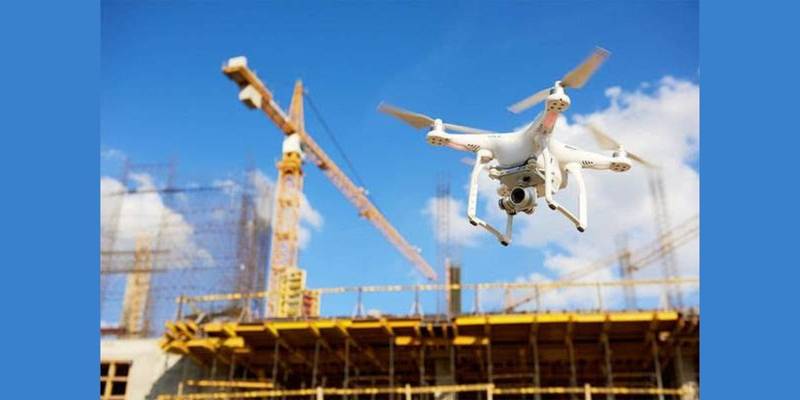The global drone construction monitoring market is expected to reach valuation of US$ 318.2 million in 2023 and further progress at a CAGR of 13.6% to reach US$ 1,149.0 million by the end of 2033.
The construction industry is undergoing a transformation with the integration of advanced technologies, and one such innovation making waves is the use of drones for construction monitoring. Drones, or unmanned aerial vehicles (UAVs), have rapidly gained popularity in the construction sector due to their ability to provide real-time data, improve project efficiency, and enhance overall safety. The drone construction monitoring market is witnessing substantial growth as construction companies recognize the numerous benefits these aerial devices bring to the table.
Key players-
- 3d Robotics Inc.
- Aerialtronics
- AeroVironment Inc.
- Delair
- DJI
- Dronedeploy Inc.
- Kespry Inc.
- Parrot Drone SAS
- Precisionhawk Inc.
- Skydio Inc.
- SZ DJI Technology Co. Ltd. (iFlight Technology Company Limited)
- Teledyne Flir LLC (Teledyne Technologies)
- Trimble Inc.
- Yuneec International Co. Ltd.
Market Dynamics:
The drone construction monitoring market has experienced a surge in demand driven by factors such as increased construction activities, the need for efficient project management, and the growing awareness of the advantages offered by drone technology. Drones equipped with high-resolution cameras, LiDAR sensors, and other advanced technologies enable construction professionals to monitor and survey sites with unprecedented precision.
Key Market Trends:
- Real-time Data and Monitoring: Drones are equipped with advanced imaging technology, allowing real-time data capture and monitoring of construction sites. This capability facilitates project managers in making informed decisions, reducing the likelihood of errors, and improving overall project efficiency. Real-time data also enables quick response to potential issues, leading to cost savings and timely project completion.
- Improved Safety Measures: Safety is a paramount concern in the construction industry. Drones play a crucial role in enhancing safety by providing a bird’s-eye view of the construction site. They can monitor and identify potential hazards, ensuring that safety protocols are adhered to. Drones also minimize the need for workers to physically access high-risk areas, reducing the risk of accidents and injuries.
- Integration with Building Information Modeling (BIM): The integration of drones with Building Information Modeling has become a prevailing trend. This integration allows construction professionals to overlay drone-captured data onto the BIM model, providing a comprehensive view of the project. This synergy enhances collaboration, improves communication among stakeholders, and contributes to better project outcomes.
- Environmental Monitoring: Drones equipped with environmental sensors are increasingly being used to monitor the impact of construction activities on the environment. This includes assessing air quality, noise levels, and other environmental factors. Construction companies are leveraging this data to ensure compliance with environmental regulations and minimize their ecological footprint.
Market Challenges:
While the drone construction monitoring market is experiencing substantial growth, it is not without its challenges. Some of the key challenges include:
- Regulatory Hurdles: The regulatory landscape for drone usage is continually evolving. Construction companies must navigate through various regulations and obtain necessary approvals for drone operations. Striking a balance between innovation and compliance remains a challenge.
- Data Security and Privacy Concerns: With the increasing use of drones for data collection, concerns about data security and privacy have become prominent. Construction companies must implement robust cybersecurity measures to protect sensitive project information and address potential privacy issues related to drone surveillance.
- Skill Gap: Effectively utilizing drone technology requires skilled operators and data analysts. The industry is facing a shortage of professionals with expertise in drone operations and data interpretation, hindering the full realization of the technology’s potential.
Read More Related Report
Drone Pipeline Inspection Market-Drone Pipeline Inspection Market Analysis, By Operation (Remotely Piloted, Optionally Piloted, Fully Autonomous), By End Users (Oil & Gas, Food & Beverages, Mining, Others), By Drone Type (Fixed Wing, Rotary Wing, Hybrid Wing), and Region – Global Market Insights 2023 to 2033
Small Drone Market-Small Drone Market Share, Size, Trends, Industry Analysis Report, By Size (Micro (6 inch), Nano (3 inch)), By Wing Type (Fixed Wing, Rotary Wing, Hybrid Wing), By Payload, End-Use Vertical and Region – Global Market Insights 2023 to 2033
Europe Drones Market-Europe Drones Market Analysis By Type (Consumer/Civil, Commercial & Military Drones) By Product Type (Fixed Wing, Rotary Wing & Hybrid Drones) By Power Source (Electric, Gas/Gasoline/Diesel & Hybrid Drones) By Payload, Sales Channel, End-Use & By Country – Global Insights 2022 to 2032
Thermal Drone Market–Thermal Drone Market Size, Share Analysis, By Drone Type (Consumer/Civil, Commercial, Military), By End Use Vertical (Agriculture, Military and Government, Mining, Healthcare, Logistics, Others), By Wavelength & Region – Global Market Insights 2023 to 2033

